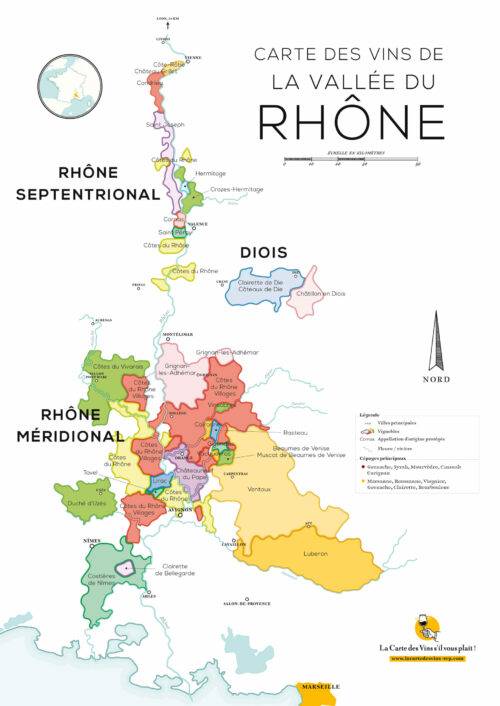The Rhône Valley
History of the wine region
Established by the Greeks in the 5th century B.C., the Rhône Valley vineyards are among the oldest in France. The Romans played an important role in their development over several centuries and the navigable Rhone River was the main trade route for the wines.
Although the collapse of the Roman Empire suddenly curtailed the wine region’s commercial growth, the Papacy revived the Rhône Valley wines’ economic growth from the 14th century onwards.
Between the 18th and the end of the 19th century, the wine region suffered from a record-breaking frost and the invasion of Phylloxera.
The turn of the 20th century saw the start of the cooperative movement within the wine industry, which led to the vineyards obtaining AOC status. Baron Leroy, a wine producer in Châteauneuf-du-Pape and co-founder of the Institut National des AOC, was instrumental in the creation of the very first AOC, the Châteauneuf-du-Pape AOC, in 1936. The following year, he also played an important role in the achievement of AOC status for the Côtes-du-Rhône. Since then, AOC status and the guarantee of quality have given the region’s wine producers a collective purpose.
Geographical location
The Rhône Valley stretches along both banks of the Rhône for about 200 km from Vienne to Avignon. It encompasses six departments, Rhône, Loire, Ardèche, Drôme, Vaucluse and Gard, and is divided into two distinct parts: the northern area, from Vienne to Valence, and the southern area, from Montélimar to Avignon.
The Rhône Valley climate and soils:
The Rhône Valley wine region is subject to two distinct climatic influences:
THE NOTHERN AREA, referred to as the septentrional area:
From Vienne to Valence, the climate is temperate continental, characterised by regular rainfall. The Bise, a cold, dry north wind, purifies the atmosphere and concentrates and accelerates the ripening of the grapes.
The main soils here are clay, gravel and granite.
THE SOUTHERN AREA, referred to as the meridional area:
South of Montélimar, the climate is Mediterranean and characterised by dry summers and winters. The annual rainfall is spread over only 70 days, mainly in autumn, which creates periods of drought. The Mistral, a frequent and particularly strong northerly wind, is beneficial to the vineyards as it removes all the moisture after the storms and clears the sky.
The main soils here are stony clay, limestone and sand.
The Rhône Valley grape varieties
The Rhône Valley grape varieties fall into two main categories: red grape varieties and white grape varieties. The red grape varieties most commonly grown in the Rhône Valley are Grenache, Syrah, Mourvèdre and Carignan. These varieties produce powerful and aromatic red wines with red fruit and spice aromas.
Among the white grape varieties most commonly grown in the Rhône Valley are Viognier, Roussanne, Marsanne and Grenache Blanc. These varieties produce dry, aromatic white wines with floral and exotic fruit aromas.
In addition to these red and white varieties, the Rhône Valley also produces rosé wines from Grenache, Syrah and Cinsault.
The Rhône Valley has been renowned for the quality of its wines since ancient times and it remains one of France’s top wine regions today. The Rhône Valley grape varieties are highly appreciated for their unique character and ability to produce high-quality wines.










